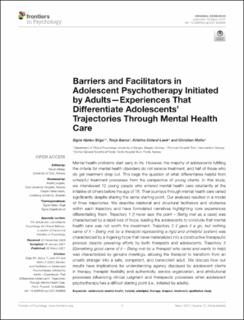| dc.contributor.author | Stige, Signe Hjelen | |
| dc.contributor.author | Barca, Tonje | |
| dc.contributor.author | Lavik, Kristina O. | |
| dc.contributor.author | Moltu, Christian | |
| dc.date.accessioned | 2022-04-21T10:50:41Z | |
| dc.date.available | 2022-04-21T10:50:41Z | |
| dc.date.created | 2021-04-07T13:38:58Z | |
| dc.date.issued | 2021 | |
| dc.identifier.issn | 1664-1078 | |
| dc.identifier.uri | https://hdl.handle.net/11250/2991936 | |
| dc.description.abstract | Mental health problems start early in life. However, the majority of adolescents fulfilling the criteria for mental health disorders do not receive treatment, and half of those who do get treatment drop out. This begs the question of what differentiates helpful from unhelpful treatment processes from the perspective of young clients. In this study, we interviewed 12 young people who entered mental health care reluctantly at the initiative of others before the age of 18. Their journeys through mental health care varied significantly despite sharing the same starting point. Our analyses resulted in a model of three trajectories. We describe relational and structural facilitators and obstacles within each trajectory and have formulated narratives highlighting core experiences differentiating them. Trajectory 1 (I never saw the point – Being met as a case) was characterized by a rapid loss of hope, leading the adolescents to conclude that mental health care was not worth the investment. Trajectory 2 (I gave it a go, but nothing came of it – Being met by a therapist representing a rigid and unhelpful system) was characterized by a lingering hope that never materialized into a constructive therapeutic process despite prevailing efforts by both therapists and adolescents. Trajectory 3 (Something good came of it – Being met by a therapist who cares and wants to help) was characterized by genuine meetings, allowing the therapist to transform from an unsafe stranger into a safe, competent, and benevolent adult. We discuss how our results have implications for understanding agency displayed by adolescent clients in therapy, therapist flexibility and authenticity, service organization, and attributional processes influencing clinical judgment and therapeutic processes when adolescent psychotherapy has a difficult starting point (i.e., initiated by adults). | en_US |
| dc.language.iso | eng | en_US |
| dc.publisher | Frontiers | en_US |
| dc.rights | Navngivelse 4.0 Internasjonal | * |
| dc.rights.uri | http://creativecommons.org/licenses/by/4.0/deed.no | * |
| dc.title | Barriers and Facilitators in Adolescent Psychotherapy Initiated by Adults – Experiences That Differentiate Adolescents’ Trajectories Through Mental Health Care | en_US |
| dc.type | Journal article | en_US |
| dc.type | Peer reviewed | en_US |
| dc.description.version | publishedVersion | en_US |
| dc.rights.holder | Copyright 2021 The Author(s) | en_US |
| cristin.ispublished | true | |
| cristin.fulltext | original | |
| cristin.qualitycode | 1 | |
| dc.identifier.doi | 10.3389/fpsyg.2021.633663 | |
| dc.identifier.cristin | 1902732 | |
| dc.source.journal | Frontiers in Psychology | en_US |
| dc.identifier.citation | Frontiers in Psychology. 2021, 12, 633663 | en_US |
| dc.source.volume | 12 | en_US |
| dc.source.issue | 633663 | en_US |

